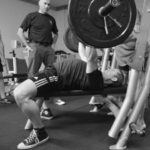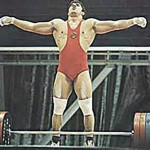We just had our second child—a daughter. She’s amazing, as is the pure lack of sleep we are experiencing. It is not uncommon for me to get around four hours of sleep a night. This makes training challenging. It makes making progress in my training even more so. The sane and rational thing to do during this period of time would be to go on a “maintenance” program.
I am neither sane nor rational, and I expect my body to make the progress I demand from it, or close to it, regardless of what my daughter or the rest of my life is doing.
In order to keep from hurting myself (like I did routinely in my thirties), I am now working with my old weightlifting coach. I tell him what’s going on in my life and what I think I can handle, and he writes my programs, with some guidelines of course.
If you have a lot going on in your life and lack the ability to fully recover from your workouts like you once did, you have zero business training the way you used to—or the way others do. Here is what routinely works for me to push my strength levels back to where they were fifteen-plus years ago, without having to work as hard as I did back then.
The Top Set Method
This has been used for time in memorium by some of the strongest guys in the world. Very simply, you work up to one top set in your training and call it a day.
Traditionally, you would go “all out” on that set. But for guys (and girls) whose recovery ability is challenged, that would be a mistake. Instead, you should grade your exertion on an RPE (rate of perceived exertion) scale of one to ten and keep your RPEs between seven and eight. Sometimes, sixes are good, too—usually when you think a weight is going to be a seven and it feels really light. Save the nines for the end of your strength cycle—one, two workouts at the most.
Here’s how I suggest you set up your training:
- Use either 5×5 or 5×3 for your workouts. Or for better results, alternate between workouts of the two.
- Start your cycle light. Use around 60-65% to give yourself momentum and train the skill of strength.
- Train three times a week using an “A-B split.” That is, alternate between an “A” training session and a “B” training session.
- Turn your warm-ups into group sets.
Group Sets
These are a little trick I learned from my weightlifting coach. You simply perform your warm-up sets back-to-back, adding load each set, with as little rest as possible between them. This excites your nervous system and allows you to put more force into each rep of that top set. And they work like a charm. You might feel a little winded after doing them, but don’t worry about that—the metabolic effects don’t have a negative neurological transfer.
Here’s how I recommend you perform this:
- Sets 1-3: As little rest as possible between, then rest 2-3 minutes after set 3.
- Set 4: First work set. Rest 3-5 minutes after.
- Set 5: Top set.
If you’re really hurting in the sleep department or using some highly technical lifts, you may want to do it the following way (which is what I do):
- Set 1: Rest long enough to add load or around 30 to 60 seconds, depending on the exercise or how you’re feeling on that exercise.
- Set 2: Rest long enough to add load or about 60 to 120 seconds, depending on the exercise or how you’re feeling on that exercise.
- Set 3: Rest 2-3 minutes.
- Set 4: Rest 3-5 minutes, usually more toward 5 minutes the heavier the load.
- Set 5: Top set.
When I was younger, I used to love the high volume, multiple “70% for 5×5” type routines. Now, I don’t have the time, energy, or desire to perform them. I’ve found I can make great, steady, measurable progress using the Top Set Method. If you’ve stalled or burnt out, you should give it a shot. It’s the most stress-free strength training method I’ve found.





First sorry for my english.-). I would like to ask you. When I do first 3 set 65% a then 4 set and top 5. Always have I add weight?
For.ex. 1=50kg,2=55kg,3=60kg,4=70kg,5=80kg.
Thank you for your answer.
Jirka
Excellent strategy. Is Perceive Effort is more a challenge of how I feel (psychological impression) than rather(muscular fatigue marker) of that period performance possibility?. Can each be right or wrong as guides to capacity if taken to
extremes?
Hey Coach Geoff, Congrats! Great article. After having just turned 40 this past year, I’ve found that I can only do the “70% 5×5” for one exercise, I usually get 5/5/4/4/3, then I’m too spent to hit it hard for another exercise. Looking forward to trying this instead. My question is: the Group Sets seem set up as if they are actually work sets, not warm ups. Do you recommend starting as light as you normally would with warm ups, i.e. 135# on a bar for Bench or do a general warm up then start with a light/moderate load for sets 1-3? Thanks!
Thank you for this great article Geoff. I’ve started training with double bells in a 5×5 setting and this is going to reinforce what I’ve been doing. Glad I can look to you for help and advice. Just finished a 5×5 with the 32’s, will be taking a light week, and will start back up after that. Hoping to move to the 36’s soon. This is a great way to get a lot of work in a short time period. Something we can all use with hectic schedules.
Great article. Throwing it into my workouts already. Thx.
Nice, John. Look forward to hearing how it works out for you.
This is great and I’m definitely going to try running through some of this stuff. One little grammar niggle: I think you meant ‘time immemorial’ rather than ‘time in memorium’ 😉
Probably, Lawrie – sleep deprivation does amazing things to your — um… uh… I forgot…
like it geoff
Thanks, Noe.
i just finished double kb 20 kg ballistic complex 8 sets 5 reps swing + clean + push press. VO2 MAX was consistent for 19 min workout. I see the body fat is going to melt away. No bad for 50yr old man…Geoff your time will even be more limited w two children, read em a book everyday! thank you for all your insight on workouts!
Right on, Cash. Lots of reading going on. Thanks for the encouragement.
Is this a daily routine?
Daniel,
3 to 4 times per week.
Interesting approach, Mr. Neupert!
Typically which exercises are you using this protocol for, and how many exercises are being done per session?
Ben Settle? The email marketing specialist?
I use it for all major exercises – right now I’m in a barbell cycle: Squats, pulls, snatches, presses, cleans, that sort of thing. I’ll also use it on bodyweight exercises where I can add extra load, like dips, chins, pistols. 2-3 exercises per session. Usually one “focus” lift.
No sir, not the e-mail marketing specialist!
Thank you for the response though- 2-3 exercises per session and one focusing on the top set method seems to make a lot of sense. Does one lift per session plus S&S swings and getups as the ‘assistance work’ seem reasonable?
That depends, Ben. What are your goals?
Personally, I’m not a big fan of mixing and matching programs. If you’re going to do S&S then just do that and only that so you can fully receive the benefits from doing so and not wonder if “something else” was distracting you from fully realizing the results you were expecting.
Goals are mainly to stay (get) strong on a minimal plan as we have baby #1 on the way in a few weeks. Also have been wanting to work with more barbell exercises after a prolonged period of KBs only. Based on your comments, I think this method would work well for a few exercises like this:
workout A: deadlift, bench press, Top Set method to RPE 6/7 for both. 50-100 swings after (skip swings if time/recovery are an issue).
workout B: squats (Top Set method to RPE 6/7), pullups (lower reps). wrap up with a few GetUps per arm after if time.
I did workout A this morning in that fashion in about 30 minutes total and felt great afterwards.
Thanks for the program and the responses!
Nice work Geoff, great post! Something most hard training parents need to take note of…Now you know how I felt during the SFG weekend with a 3 month old and 3 other little ones at home. 🙂 Congrats BTW
Thanks, Jeremy. 4?? Wow. SFG must’ve felt like a vacation. 😉
Love this Geoff!
Personally I’ve never been a high volume fan (even though I know it can be effective) so I find working up to one (or two) actual work sets in a few key lifts suits me best and ensures I enjoy my training.
Great post.
Thanks, Carl.
Funny thing is, when I was younger, I WAS a volume-junky. I always equated more work with more results. How false that is.
A quick update:
A new PB this morning is all the proof I need that this approach works! As a bonus I completed a minimalist, full body routine in the time it took someone else in the gym to fiddle with the incline bench in the Smith Machine rack and pump out some very mediocre looking sets!
Keep up the great writing and work!
Excellent, Carl!
Great article. The topset method sounds very similar to 5/3/1. I’ll have to give it a go in my next cycle. =)
Thanks, Matt.
In a way, it is similar to 5/3/1. Only the percentages aren’t as rigid, I use RPEs, I rarely train to the edge of technical failure, like Jim advocates in his book. Nothing wrong with that, except in this state I just can’t recover from that type of training.
That makes sense. Recovery is vital for training. How high into RPE do you usually go? Is it more of a by feel each day thing? Sorry if someone else has already asked this question.
I usually keep it at around a 7 or 8 until the last week of a cycle then I’ll go to a 9 if I feel good.